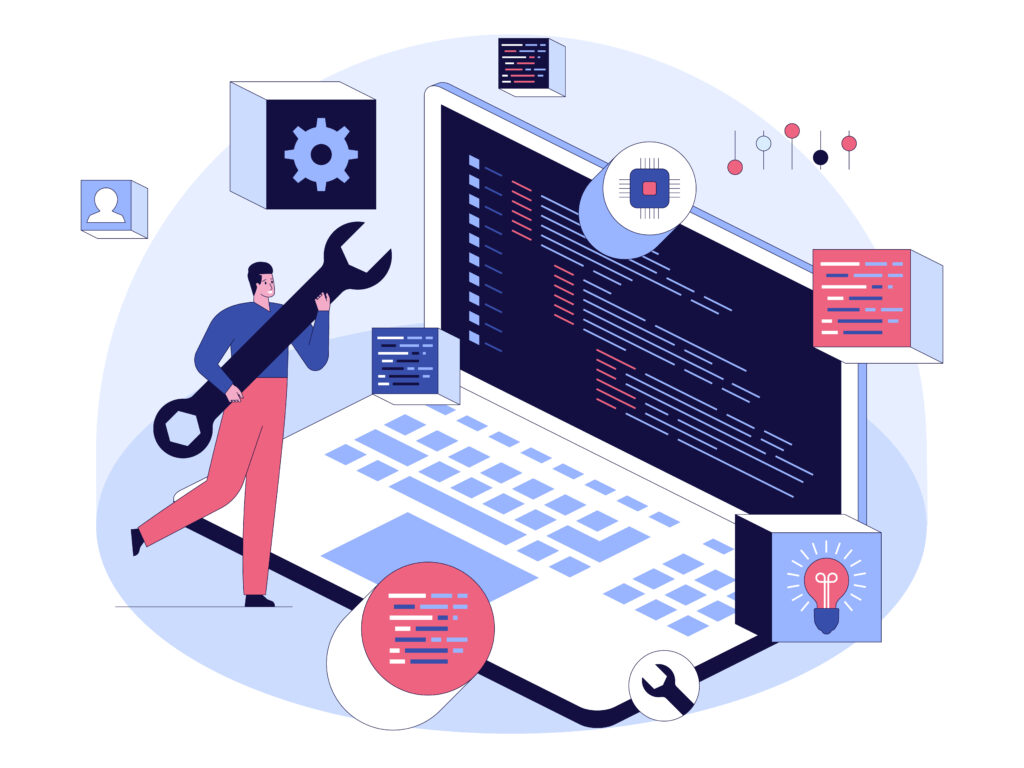In today’s fast-paced digital world, when software upgrades happen like clockwork and user expectations are at an all-time high, staying ahead of the curve in Quality Assurance (QA) is no longer a luxury, but a requirement. Consider crossing a busy highway: using obsolete testing methods is like to relying on a single, worn-out traffic signal, which is dangerous and inefficient.
But do not be afraid! The realm of quality assurance has developed considerably. Remember when manual testing was the only choice? Fortunately, those days are behind us. We now have access to cutting-edge trends and technologies, ranging from AI-powered testing to the magic of continuous integration and deployment (CI/CD).
By adopting these trends, your QA staff can transition from reactive firefighters to proactive problem solvers, ensuring that your software’s quality and performance are nothing short of exceptional. So, saddle up and prepare to enter the thrilling world of modern QA, where you’ll uncover the trends that will help optimize your software!
Shift-Left Testing
Explanation of Shift-Left Testing
Move past the idea of QA as an afterthought and introduce yourself to the concept of Shift-Left Testing. Consider a development process in which testing begins early and continues throughout the whole software development lifecycle (SDLC). This is the essence of Shift-Left Testing.
Consider it like building a house. Traditionally, you wouldn’t wait until the roof was installed to inspect the foundation, right? Shift-Left Testing follows the same logic. Catching problems as well as flaws early on -when the code is still fresh-making improvements easier, saving time, money and a lot of headaches in the long run.
Benefits of early testing in the development lifecycle
Here are some of the major advantages of using a Shift-Left approach:
- Early Bug Detection: The faster you discover a bug, the easier and less expensive it is to remedy. Shift-Left Testing identifies difficulties early in the development cycle, preventing them from escalating into serious problems later
- Better Code Quality: When testing is done at every stage of the process, developers get constant feedback that helps them build cleaner, more reliable code
- Faster Time to Market: You may expedite your software development process and get it onto the market more quickly by identifying and addressing defects early on
Shift-Left Testing is an important change in the way we approach software development.
Test Automation
Current state and advancements in test automation tools
The field of test automation has seen significant change. The days of cumbersome, script-heavy tools requiring a high level of coding knowledge are long gone. Modern test automation tools come with an easy-to-use UI, cutting-edge features and smooth workflow integration.
Here’s an overview of test automation as it is right now:
- Testing driven by AI: In the field of automation, artificial intelligence is gaining traction. AI-powered solutions enable more intelligent and effective test execution by learning from previous test data and user behavior.
- Self-Healing Tests: When code changes, there’s no need for manual updates! Self-healing tests may adapt automatically to changes in the code, which sparing QA engineers time and work.
- Cloud-based Automation: Test automation is now more accessible than ever thanks to cloud-based solutions’ scalability, flexibility and remote access.
Real-world examples and success stories
Test automation goes beyond theory, delivering tangible benefits for companies across various sectors. Check out these success stories:
- A prominent e-commerce platform streamlined its testing process with a automation framework, resulting in a 70% reduction in manual testing efforts and significantly faster software releases.
- A major financial institution enhanced its testing practices by implementing AI-powered tools, leading to a 25% increase in test coverage and a substantial decrease in production bugs.
These examples highlight the effectiveness of test automation in driving impressive outcomes for businesses. Next, we’ll explore the realm of AI and Machine Learning in Quality Assurance.
AI and Machine Learning in Quality Assurance
How AI is transforming quality assurance processes:
- Intelligent Test Case Creation: AI is capable of examining past data and user behavior patterns to create test cases that are automatically generated and efficient, making sure that all important features are covered.
- Predictive Maintenance: By using code patterns and bug history to identify probable flaws, machine learning algorithms can take proactive steps to stop problems before they start.
- Visual Testing Automation: Visual regression testing can be automated by AI-powered solutions, assuring that UI elements stay visually appealing and consistent throughout the development process.
Examples of AI-driven testing tools
AI-driven testing products are abundant in the market. Here are few examples:
- Applitools: This AI-driven technology ensures UI uniformity across all platforms and devices and automates visual testing.
- io: This tool makes intelligent test cases and speeds up the test automation process by utilizing machine learning.
- UiPath: This platform can automate tedious manual testing processes with its sophisticated RPA (Robotic Process Automation) solution.
QA teams can liberate time from routine work and concentrate on strategic projects that promote innovation as well as quality by embracing AI and machine intelligence. Below discusses the significance of Continuous Integration and Continuous Deployment (CI/CD) in contemporary QA in the next section.
Continuous Integration and Continuous Deployment (CI/CD)
Importance of CI/CD in modern quality assurance:
- Early Feedback: CI/CD pipelines include automated testing throughout the development process. This enables QA engineers to find and resolve errors early on, preventing them from accumulating and generating larger problems later
- Improved Quality: With frequent deployments, faults are identified and handled more rapidly, resulting in higher overall program quality
- Reduced Risk: CI/CD pipelines reduce human error during the deployment process, resulting in a more consistent and dependable software release cycle
Best practices for integrating quality assurance into CI/CD pipelines:
- Shift-Left Testing: As was previously said, using a shift-left strategy helps ensure that testing takes place at all stages of the development process, not just at the conclusion.
- Emphasis on Automation: Use technologies for automated testing to make the CI/CD pipeline’s testing process more efficient.
- Make Regression Testing a Priority: Make sure regression tests are regularly executed to identify any inadvertent functional breakdowns brought about by fresh code modifications.
- Continuous Monitoring: After software is deployed, use monitoring tools to keep an eye on its performance and spot any problems.
Exploratory Testing
What is exploratory testing?
Exploratory testing is a dynamic testing approach in which the tester actively navigates the software, identifying issues and gaining insights through their experience and creativity. Exploratory testing is more flexible and lets testers modify their strategy as they go.
How it complements automated testing:
- Think creatively: Manual investigation might reveal edge cases and problems with the user experience that automated testing might overlook
- Find usability issues: Testers can evaluate how intuitive the program is and pinpoint places where the user experience needs to be enhanced
- Adapt to change: Throughout the software development process, exploratory testing can be made to work with changes in the functionality of the program
Software quality assurance teams can attain a more thorough approach by merging automated and exploratory testing. Below the importance of the Software Quality Assurance Engineer’s work and the abilities they contribute is outlined.
Software Quality Assurance Engineer: The Unsung Hero
The evolving role of the quality assurance engineer
Gone are the days when QA engineers would just punch through repetitive test cases. Today’s QA specialists are key players in the software development process. They are expert problem solvers who use a wide range of talents and cutting-edge technology to assure software quality and user happiness.
Skills and qualifications in demand
The ideal Software Quality Assurance Engineer combines technical expertise and soft capabilities. Here are some of the most desired qualifications:
Technical Skills:
- Expertise in testing methods (exploratory, automated, etc.)
- Understanding the CI/CD pipelines
- Experience using test automation tools
- Knowledge of scripting languages (e.g., Python and Java)
- Experience with bug tracking tools
Soft skills:
- Excellent communication and teamwork abilities
- Analytic and problem-solving skills
- Excellent attention to detail
- Critical thinking and creativity
- A love for quality and users
QA engineer’s problem-solving superpowers
The Software Quality Assurance Engineers may not wear capes, but they possess a unique set of superpowers. They could detect bugs, analyze intricate code and innovate creatively.
Through their unwavering dedication and problem-solving skills, they ensure that the software we interact with daily is dependable, functional and enjoyable
Conclusion
Recap of key trends
Throughout this blog article, we’ve examined some significant developments shaping the landscape of software quality assurance:
- Shift-Left Testing: Integrating testing throughout the development process to find bugs early and enhance code quality
- Test Automation: Using automation tools to streamline repetitive activities and accomplish complete test coverage
- AI and machine learning in quality assurance: Using AI-powered technologies to generate intelligent test cases, perform predictive maintenance and automate visual testing
- Continuous Integration and Continuous Deployment (CI/CD): Incorporating QA into CI/CD pipelines to provide regular feedback, enhance software quality and mitigate risk
- Exploratory Testing: In addition to automated testing, an exploratory method is used to find unforeseen flaws and improve user experience
Encouragement to embrace these trends to stay competitive
The software development world is continuously changing and so should your QA processes. By embracing these trends and investing in competent Software Quality Assurance Engineers, you can keep your software bug-free, provide excellent user experiences and stay ahead of the competition.
Are you ready to raise your QA game to the next level? Begin by implementing these trends into your development process and consider employing top-tier QA people with the necessary skills and desire to flourish in this dynamic sector. Remember that investing in a quality QA team will pay off in the long term by assuring the success and user satisfaction of your software products.
Staffing Made Effortless. Let the Experts Handle Your Hiring
Helping companies discover the perfect talent for their needs. Finding the right individuals to drive your success is what we excel at.





